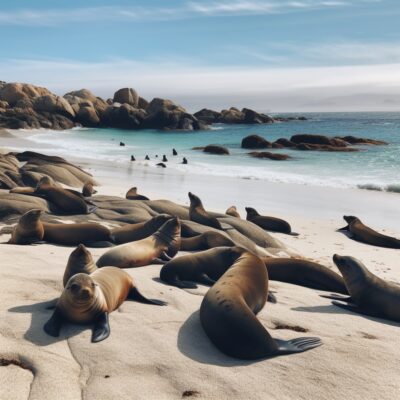In a concerning development along the coastal areas of southern California, numerous dead sea lions and dolphins have been discovered. More than 100 dolphins and over a dozen sea lions have either been found dead or critically ill. Alarming reports indicate that some sea lions are displaying unusually aggressive behavior. Authorities attribute this distressing situation to an algae bloom caused by a specific type of algae known as Pseudo-Nietzsche. This algae produces a neurotoxin called domoic acid, which poses a threat not only to aquatic life but also to humans when they consume contaminated seafood.
Algae Bloom Rising Problem is Beyond California
While the issue of algae bloom and its harmful effects have been predominantly associated with the western United States, recent findings reveal similar occurrences along the Indian coastline. Scientists have identified climate change and rising sea surface temperatures as contributing factors to the rise of algae bloom. This phenomenon is expected to intensify in the future, posing risks to human health, fishery sectors, and tourism.
Harmful Algal Bloom

Algae are photosynthetic organisms that can be found in both marine and freshwater environments. Certain types of algae, such as Pseudo-Nietzsche, can produce domoic acid, a neurotoxin that can be poisonous to seabirds and fish if ingested. Unfortunately, this toxin can make its way through the food chain, affecting larger marine animals like dolphins, sea lions, and even humans.
Disturbing Reports and Overwhelming Impact
According to CNN, officials have received more than 1,000 reports in recent weeks from beachgoers, residents, and tourists regarding sick, dying, and dead sea mammals along the California coast. The situation is described as one of the largest in memory, with overwhelming numbers of distressed animals being discovered. Marine-life experts strongly believe that the toxic algal bloom is the root cause, although further testing is needed to confirm this.
Unprecedented Crisis and Troubling Numbers
Rescue organizations and scientists are grappling with the scale of the crisis. Channel Islands Marine & Wildlife Institute (CIMWI), a marine mammal rescue organization based in Santa Barbara, has responded to over 100 dead sea lions and more than 300 live sea lions showing signs of domoic acid ingestion. Shockingly, the death toll for dolphins has risen to 100, with the bloom affecting species that typically inhabit areas far from the shore.
Growing Concerns and Worsening Outbreaks
Experts note that harmful algal blooms appear to be increasing in intensity and frequency. Domoic acid levels recorded in animal tissue samples reached an all-time high last year. The current outbreak is suspected to be just as severe or potentially worse. Scientists warn that rising ocean acidity due to the climate crisis provides favorable conditions for the proliferation of harmful algae while warming ocean temperatures contribute to the spread of toxic algae species worldwide.
Addressing the Crisis and Seeking Solutions
Scientists are diligently working to understand the causes behind the current outbreak and the transition of algae into harmful blooms. Predictive models like the California Harmful Algae Risk Mapping (C-Harm) system have been developed to forecast domoic acid outbreaks. On the ground, rescue organizations continue to provide care and support to affected sea lions, sharing their findings, and contributing samples for further analysis.
As human activities play a role in exacerbating the crisis, efforts are being made to address factors such as wastewater treatment, agricultural runoff, and reducing pollution. Incremental changes are being implemented to mitigate the harmful effects of algae blooms. Scientists emphasize the importance of studying sentinel species like sea lions, whose health serves as an indicator of environmental disturbances and magnitudes.
As scientists and experts delve deeper into understanding and combatting harmful algal blooms, ongoing research, and collaborative efforts are crucial to protect marine life, human health, and the delicate balance of our oceans. By addressing the root causes and taking proactive measures, we can hope to minimize the devastating impact of these blooms and ensure the well-being of our coastal ecosystems for future generations.













